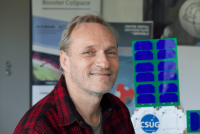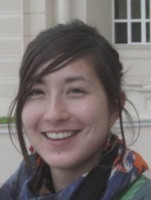Climate & Environment
Space & Planetery
Post-Doctoral Fellowships
France
SimCME - Numerical simulations of solar coronal mass ejections
Context
Coronal mass ejections (CMEs) and flares are different manifestations of the activity of our closest star: the Sun.
When CMEs lift-off they travel into the interplanetary medium and, quite often, generate interplanetary shocks. These shocks together with solar flares are the major sources of Solar Energetic Particles (SEP), i.e., particles travelling to near-relativistic speeds. At times, these solar storms can hit the Earth. Therefore, it is not surprising that CMEs are considered to be one of the major drivers of space weather.
Geomagnetic storms not only can significantly affect, and eventually compromise, the human efforts in the space explorations, but also affect the everyday life: (1) the ionospheric perturbations caused by geomagnetic storms can influence many telecommunication systems and the GPS accuracy, (2) at the ground, in long electrically conducting devises, such as power grids, the induced currents may even burn the voltage transformers, causing major blackouts, and (3) in order to avoid high radiation doses associated with solar storms, transatlantic flights are forced to follow non-polar routes resulting in incent losses. Therefore, in a technology-dependent era, the environmental risks associated with space weather are becoming enormous.
The proposed project aims to investigate which are the critical conditions for the onset of CMEs, i.e. one of the major drivers of solar storms. The understanding of these critical conditions and the capability to foresee whether or not a solar eruptions would hit the Earth constitute the basis of any reliable attend of predicting the weather in space.
Short- and long-term objectives
The goal of the proposed project is to investigate if an unprecedented method for unraveling the main physical mechanisms that trigger CMEs can be devised.
Numerical MHD simulations will be performed to systematically investigate the influence of different observationally-inspired photospheric drivers and to determine under which conditions a CME is – or is not – initiated. This will answer fundamental questions about what can trigger CMEs.
A well-observed – in terms of data coverage – solar eruption will be selected and the pre-eruptive dynamics of the AR as well as the initiation of the CME will be studied. The developed MHD models will be used to deduce the trigger of this eruption and to study its initial dynamics. This will clarify which is the trigger of the observed CME.
The knowledge acquired during the interpretation of the different features of the observed event in terms of the MHD models, will allow a better understanding of which are the observational features that may later be used to predict the behavior of a given AR.
Finally, the undertaken research will allow us to identify the current major difficulties – such as computational resources, numerical algorithms, accurateness of the photospheric driving, etc. – that have to be faced when aiming to extend this approach to a statistically relevant number of events. The outcomes of this project, will contribute to the development of a quantitative, model-based space weather prediction framework that could later-on complement, and eventually replace, the empirical models currently available.
Preliminary studies
The present project will build on the candidate’s competences on performing data-inspired MHD simulations of solar ARs and analysis of solar images as well as on the worldwide-recognized expertise in the field of MHD modeling of solar eruptions, magnetic field reconstructions and analysis of solar images available at the hosting laboratory LESIA.
In a precedent study, the candidate investigated the response of the solar corona when asymmetric, data-inspired photospheric flows were used to drive an eruption. Similarly, more idealized numerical MHD simulations devoted to disentangle the trigger of the eruption and the close CME-flare association have long been performed at LESIA by the applicant’s adviser Dr. G. Aulanier and his collaborators.
Research design and methods
For the MHD modeling part of the project, the MHD model developed at LESIA by the candidate’s adviser will be used. The effect of different convergence, shearing/twisting flows as well as flux dispersal and flux emergence/cancellation spanning a parameter space compatible with the observations will be studied. The equilibrium properties of the flux rope as well as the pre-eruptive evolution will be analyzed. We will disentangle the different dynamical regimes of the initiation phase in terms of the local Alfven speed in order to clarify which is the trigger of the eruption. Finally, a selected subset of the aforementioned MHD models will be re-run in a non-zero plasma-beta regime. This will allow us, for the first time, to systematically investigate the effect of a non-zero plasma-beta environment in the CME initiation.
For the event observations part of the project, a non-complex, textbook-like event associated with a fairly simple AR will be selected. We will choose an event that is observed in optimal conditions with respect to the location on the Sun, the location in one or more spacecraft’s field of views, the availability of multi-wavelength as well as in-situ observations and the availability and/or reducibility of vector magnetograms. For the selected event, the morphology of the AR, the CME direction and velocity, and the changes in the magnetic field topology will be investigated. The developed MHD models will be used to interpret the observed dynamic and to identify what triggered the CME. Finally, trigger-related features will be studied in order to clarify which are the critical observed features that can later be used to predict the behavior of other events without the need of vast numerical studies.
Coronal mass ejections (CMEs) and flares are different manifestations of the activity of our closest star: the Sun.
When CMEs lift-off they travel into the interplanetary medium and, quite often, generate interplanetary shocks. These shocks together with solar flares are the major sources of Solar Energetic Particles (SEP), i.e., particles travelling to near-relativistic speeds. At times, these solar storms can hit the Earth. Therefore, it is not surprising that CMEs are considered to be one of the major drivers of space weather.
Geomagnetic storms not only can significantly affect, and eventually compromise, the human efforts in the space explorations, but also affect the everyday life: (1) the ionospheric perturbations caused by geomagnetic storms can influence many telecommunication systems and the GPS accuracy, (2) at the ground, in long electrically conducting devises, such as power grids, the induced currents may even burn the voltage transformers, causing major blackouts, and (3) in order to avoid high radiation doses associated with solar storms, transatlantic flights are forced to follow non-polar routes resulting in incent losses. Therefore, in a technology-dependent era, the environmental risks associated with space weather are becoming enormous.
The proposed project aims to investigate which are the critical conditions for the onset of CMEs, i.e. one of the major drivers of solar storms. The understanding of these critical conditions and the capability to foresee whether or not a solar eruptions would hit the Earth constitute the basis of any reliable attend of predicting the weather in space.
Short- and long-term objectives
The goal of the proposed project is to investigate if an unprecedented method for unraveling the main physical mechanisms that trigger CMEs can be devised.
Numerical MHD simulations will be performed to systematically investigate the influence of different observationally-inspired photospheric drivers and to determine under which conditions a CME is – or is not – initiated. This will answer fundamental questions about what can trigger CMEs.
A well-observed – in terms of data coverage – solar eruption will be selected and the pre-eruptive dynamics of the AR as well as the initiation of the CME will be studied. The developed MHD models will be used to deduce the trigger of this eruption and to study its initial dynamics. This will clarify which is the trigger of the observed CME.
The knowledge acquired during the interpretation of the different features of the observed event in terms of the MHD models, will allow a better understanding of which are the observational features that may later be used to predict the behavior of a given AR.
Finally, the undertaken research will allow us to identify the current major difficulties – such as computational resources, numerical algorithms, accurateness of the photospheric driving, etc. – that have to be faced when aiming to extend this approach to a statistically relevant number of events. The outcomes of this project, will contribute to the development of a quantitative, model-based space weather prediction framework that could later-on complement, and eventually replace, the empirical models currently available.
Preliminary studies
The present project will build on the candidate’s competences on performing data-inspired MHD simulations of solar ARs and analysis of solar images as well as on the worldwide-recognized expertise in the field of MHD modeling of solar eruptions, magnetic field reconstructions and analysis of solar images available at the hosting laboratory LESIA.
In a precedent study, the candidate investigated the response of the solar corona when asymmetric, data-inspired photospheric flows were used to drive an eruption. Similarly, more idealized numerical MHD simulations devoted to disentangle the trigger of the eruption and the close CME-flare association have long been performed at LESIA by the applicant’s adviser Dr. G. Aulanier and his collaborators.
Research design and methods
For the MHD modeling part of the project, the MHD model developed at LESIA by the candidate’s adviser will be used. The effect of different convergence, shearing/twisting flows as well as flux dispersal and flux emergence/cancellation spanning a parameter space compatible with the observations will be studied. The equilibrium properties of the flux rope as well as the pre-eruptive evolution will be analyzed. We will disentangle the different dynamical regimes of the initiation phase in terms of the local Alfven speed in order to clarify which is the trigger of the eruption. Finally, a selected subset of the aforementioned MHD models will be re-run in a non-zero plasma-beta regime. This will allow us, for the first time, to systematically investigate the effect of a non-zero plasma-beta environment in the CME initiation.
For the event observations part of the project, a non-complex, textbook-like event associated with a fairly simple AR will be selected. We will choose an event that is observed in optimal conditions with respect to the location on the Sun, the location in one or more spacecraft’s field of views, the availability of multi-wavelength as well as in-situ observations and the availability and/or reducibility of vector magnetograms. For the selected event, the morphology of the AR, the CME direction and velocity, and the changes in the magnetic field topology will be investigated. The developed MHD models will be used to interpret the observed dynamic and to identify what triggered the CME. Finally, trigger-related features will be studied in order to clarify which are the critical observed features that can later be used to predict the behavior of other events without the need of vast numerical studies.
To add or modify information on this page, please contact us at the following address: community.research@axa.com

Francesco
ZUCCARELLO
Institution
Observatoire de Paris
Country
France
Nationality
Italian


